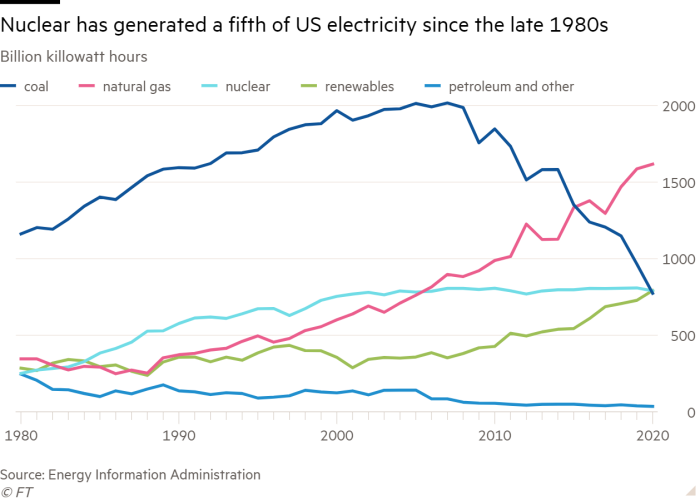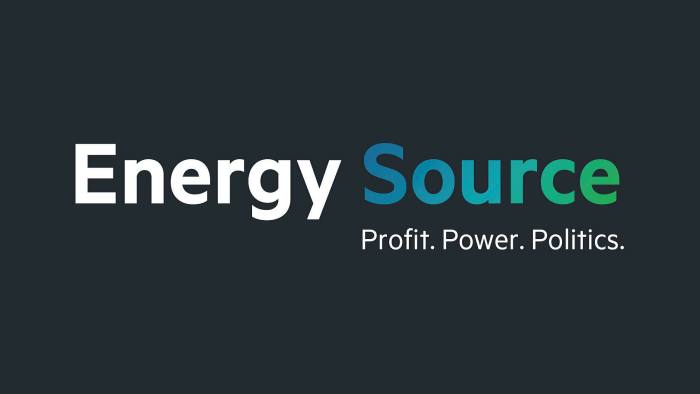
[ad_1]
As President Joe Biden pushes his climate agenda through Congress, an industry that has been on the back foot for decades is getting a second look — and fresh funding.
Nuclear energy is a steady source of carbon-free electricity. But the US nuclear-generating network has been shrinking for years because of falling power costs that make many plants uncompetitive.
The $1.2tn bipartisan infrastructure bill that Biden signed into law on Monday provides $6bn in grants for struggling reactors. The president’s “Build Back Better” spending bill under debate in Congress would also establish a nuclear power production tax credit worth billions of dollars.
The federal funding follows bailouts in several US states for nuclear generators on the brink of closure.
“The bottom line is that you’ve got a lot of safe and reliable plants out there that are providing zero-carbon electricity exactly when our nation and the world need it most,” said Jeremiah Baumann, deputy chief of staff at the Department of Energy. “We can’t afford to have the setback of losing a lot of carbon-free electricity.”

The US efforts are aimed primarily at propping up its network of 93 working reactors rather than building new ones. Nuclear has provided about a fifth of the country’s electricity for the past three decades and accounts for about half the country’s zero-carbon generation.
But emerging power sources have undercut many nuclear plants. High-efficiency turbines fuelled by cheap natural gas and renewable generators supported by subsidies have driven down wholesale power costs. This has made it difficult for nuclear generators — whose operating costs are largely fixed — to compete.
Since 2013, 13 US reactors have shut down, with New York’s Indian Point becoming the latest in April. California’s Diablo Canyon will join the list in 2025. A recent report from the Rhodium Group found that, under current policy, more than half of the nation’s nuclear plants will be retired by the end of the decade.
Stemming this decline, the Biden administration has made clear, is an essential part of its efforts to decarbonise the US power grid by 2035 and the wider economy by 2050.
“What we’re seeing is a fundamental shift in the recognition of the importance of nuclear energy as a source of . . . large-scale, low-carbon energy generation,” said John Kotek, vice-president of policy development at the Nuclear Energy Institute, a trade association.
“You probably have to go back to the ’60s and ’70s to see this level of support for nuclear energy in the US,” he added. The US nuclear energy industry has fought to counter an unsafe image since a partial meltdown in 1979 at Pennsylvania’s Three Mile Island plant.

Critics argue that government supports amount to an expensive subsidy for an industry that finds it increasingly difficult to survive. A 2018 report from the Union of Concerned Scientists found that more than a third of American nuclear power plants were unprofitable or scheduled to close, and estimated an average cost of $814m annually to bring plants back to a break-even point.
Exelon, a Chicago-based power company which operates the largest US reactor fleet, had threatened to close two nuclear plants in Illinois by the end of this year. But the Byron and Dresden plants avoided shutdown at the last minute when the state legislature approved a $694m aid package in September. The move left four of the six plants in Illinois reliant on state funds.
Four other US states, including New York, New Jersey and Connecticut, have also intervened to help their nuclear generators.
Advocates argue that while many nuclear plants may struggle to compete, markets often fail to account for their emissions benefits.
“The way I would see it is that nuclear historically has not been compensated for its clean air attributes,” said David Brown, Exelon’s vice-president of federal government affairs and public policy. “So as states and the federal government get more aggressive with their clean air goals they are recognising the importance of maintaining the existing nuclear fleet.”
The federal infrastructure law will allot funds by auction to merchant generators that can prove they are on the brink of closure. Details will be hashed out by the US energy department over the next four months.
Companies are more excited about the Biden spending bill, however, which as drafted would introduce a production tax credit worth $15 a megawatt-hour. Kotek said the tax credit was “an essential step in effectively addressing the economic hurdles”.
The US has little appetite to build new large-scale nuclear plants. The only reactors under construction, at Southern Company’s Vogtle plant in Georgia, have doubled in cost to about $28bn after repeated delays.
Instead, the industry hopes a new breed of small modular reactors — support for which is also provided in the infrastructure law — will play a big role in future generation.
For now the focus remains on extending the life of the existing plants.
“It’ll be a lot easier to get there if we build on top of what we have instead of tearing it down and then fancying that we’re going to have to do a grand campaign to build an alternative again,” said John Parsons, an executive director of the centre for energy and environmental policy research at the Massachusetts Institute of Technology.
Twice weekly newsletter

Energy is the world’s indispensable business and Energy Source is its newsletter. Every Tuesday and Thursday, direct to your inbox, Energy Source brings you essential news, forward-thinking analysis and insider intelligence. Sign up here.
[ad_2]
Source link